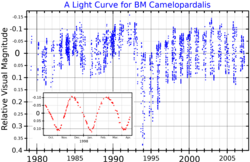Astronomy:12 Camelopardalis
| Observation data Equinox J2000.0]] (ICRS) | |
|---|---|
| Constellation | Camelopardalis |
| Right ascension | 05h 06m 12.13609s[1] |
| Declination | +59° 01′ 16.8261″[1] |
| Apparent magnitude (V) | 6.08[2] |
| Characteristics | |
| Evolutionary stage | giant |
| Spectral type | K0 IIIe[3] |
| B−V color index | 1.112±0.009[2] |
| Variable type | RS CVn[4] |
| Astrometry | |
| Radial velocity (Rv) | −1.92±0.27[2] km/s |
| Proper motion (μ) | RA: −2.264[1] mas/yr Dec.: −26.949[1] mas/yr |
| Parallax (π) | 4.6513 ± 0.0706[1] mas |
| Distance | 700 ± 10 ly (215 ± 3 pc) |
| Absolute magnitude (MV) | −0.332[5] |
| Details | |
| 12 Cam A | |
| Mass | 1.1[6] M☉ |
| Radius | 23.08+0.75 −1.34[1] R☉ |
| Luminosity | 212±4[1] L☉ |
| 12 Cam B | |
| Mass | 0.6[6] M☉ |
| Other designations | |
| Database references | |
| SIMBAD | data |
12 Camelopardalis is a binary star in the northern circumpolar constellation of Camelopardalis, located 700 light years away from the Sun as determined from parallax measurements.[1] It forms a double star with 11 Camelopardalis, which is only 3 arcminutes away. The system has the variable star designation BM Camelopardalis; 12 Camelopardalis is the Flamsteed designation. It is just visible to the naked eye, appearing as a dim, orange-hued star with an apparent visual magnitude of 6.08.[2] The system is moving closer to the Earth with a heliocentric radial velocity of −2 km/s.[2]

Abt et al. (1969) determined this to be a single-lined spectroscopic binary system and computed an orbital solution with a period of 80.17 days and an eccentricity of 0.35.[9] However, what appeared to be an ellipticity effect with a period of 79.93±0.05 d was found, which was inconsistent with the computed orbit, and the lack of modulation of the amplitude did not fit with the large orbital eccentricity. Hall et al. (1995) made additional measurements, finding an orbital period of 80.9 days and an eccentricity that is statistically indistinguishable from zero.[6]
The visible component is an evolved giant star with a stellar classification of K0 IIIe,[3] showing strong emission lines.[9] It is an RS Canum Venaticorum variable and its brightness varies by 0.14 magnitudes with a period of 82.9 days due to starspots.[4] The star is most likely rotating in synchronous manner with its orbital period.[6] The magnetic activity has two overlapping cycles of 14.8 and 8.5 years, with the activity occurring at two latitudes.[8] BM Cam emits X-rays and is the designated X-ray source 1H 0501+592.[10] It has been detected by HEAO 1, the Einstein Observatory, and ROSAT.
References
- ↑ 1.0 1.1 1.2 1.3 1.4 1.5 1.6 1.7 Brown, A. G. A. (August 2018). "Gaia Data Release 2: Summary of the contents and survey properties". Astronomy & Astrophysics 616: A1. doi:10.1051/0004-6361/201833051. Bibcode: 2018A&A...616A...1G. Gaia DR2 record for this source at VizieR.
- ↑ 2.0 2.1 2.2 2.3 2.4 Anderson, E.; Francis, Ch. (2012), "XHIP: An extended hipparcos compilation", Astronomy Letters 38 (5): 331, doi:10.1134/S1063773712050015, Bibcode: 2012AstL...38..331A.
- ↑ 3.0 3.1 Keenan, Philip C.; McNeil, Raymond C. (1989), "The Perkins catalog of revised MK types for the cooler stars", Astrophysical Journal Supplement Series 71: 245, doi:10.1086/191373, Bibcode: 1989ApJS...71..245K.
- ↑ 4.0 4.1 Samus, N. N. et al. (2017), "General Catalogue of Variable Stars", Astronomy Reports, 5.1 61 (1): 80–88, doi:10.1134/S1063772917010085, Bibcode: 2017ARep...61...80S.
- ↑ Böhm-Vitense, Erika et al. (December 2000), "Ultraviolet Emission Lines in BA and Non-BA Giants", The Astrophysical Journal 545 (2): 992–999, doi:10.1086/317850, Bibcode: 2000ApJ...545..992B.
- ↑ 6.0 6.1 6.2 6.3 Hall, D. S. et al. (March 1995), "A spectroscopic and photometric study of 12 BM Camelopardalis", Astronomical Journal 109 (3): 1277–1288, doi:10.1086/117360, Bibcode: 1995AJ....109.1277H.
- ↑ "12 Cam". SIMBAD. Centre de données astronomiques de Strasbourg. http://simbad.u-strasbg.fr/simbad/sim-basic?Ident=12+Cam.
- ↑ 8.0 8.1 Zboril, M.; Messina, S. (April 2009), "Magnetic activity on 12 Cam and 29 Dra from long-term photometry", Astronomische Nachrichten 330 (4): 377, doi:10.1002/asna.200811190, Bibcode: 2009AN....330..377Z.
- ↑ 9.0 9.1 Abt, Helmut A. et al. (August 1969), "12 Cam., Calcium emission in giant binaries.", Astrophysical Journal 157: 717, doi:10.1086/150108, Bibcode: 1969ApJ...157..717A.
- ↑ Wood, K. S.; Meekins, J. F.; Yentis, D. J.; Smathers, H. W.; McNutt, D. P.; Bleach, R. D. (Dec 1984), "The HEAO A-1 X-ray source catalog", Astrophysical Journal Supplement Series 56 (12): 507–649, doi:10.1086/190992, Bibcode: 1984ApJS...56..507W.
 |


